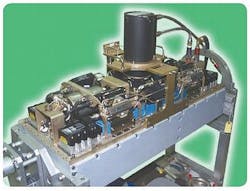Navy chooses electronic warfare transmitter antennas from Cobham for EA-18G and EA-6B aircraft
PATUXENT RIVER NAS, Md., 24 Feb. 2012. U.S. Navy combat aviation experts needed a series of airborne antennas for the AN/ALQ-99 low-band transmitter system aboard the Boeing EA-18G Growler and Northrop Grumman EA-6B Prowler carrier-based electronic warfare jets. They found their solution from the Cobham plc Sensor and Antenna Systems segment in Lansdale, Pa.
Officials of the U.S. Naval Systems Command at Patuxent River Naval Air Station, Md., awarded Cobham Sensor and Antenna a $39 million contract modification Thursday for 48 low-band transmitters; 13 vertical polarized antennas; and 28 horizontal polarized antennas for the AN/ALQ-99 low band transmitter aboard the EA-18G Growler and EA-6B Prowler aircraft.
The ALQ-99 low band transmitter is deployed on EA-6B and EA- 18G electronic warfare aircraft, and are designed to jam enemy radar and communications systems the operate in the lower frequency regime. The modern ALQ-99 replaces an older version of the ALQ-99 band 1, band 2, and band 2/3 transmitters with one high-reliability transmitter with mission-specific antenna sets.
The latest electronic warfare antennas for the ALQ-99 were developed by the BAE Systems Surveillance and Attack business unit, which BAE Systems sold to Cobham in 2007.
Older versions of the ALQ-99 low-band radar and communications jammer also were on earlier models of the EA-6B Prowler, as well as on the now-retired EF-111 Raven, an electronic warfare version of the old F-111 supersonic bomber.
The computer-controlled AN/ALQ-99 tactical jamming system intercepts and automatically processes radar signals to jam many different kinds of enemy radar systems high effective radiated power.
The antennas for the AN/ALQ-99 fit in mission-configured jammer pods aboard the host aircraft. A universal exciter in each onboard pod interfaces with the onboard system and is under aircraft crew control.
On the most recent antenna contract, Cobham will do the work in Lansdale, Pa., and should be finished by August 2014. For more information contact Cobham Sensor and Antenna online at www.cobham.com, or Naval Air Systems Command at www.navair.navy.mil.

